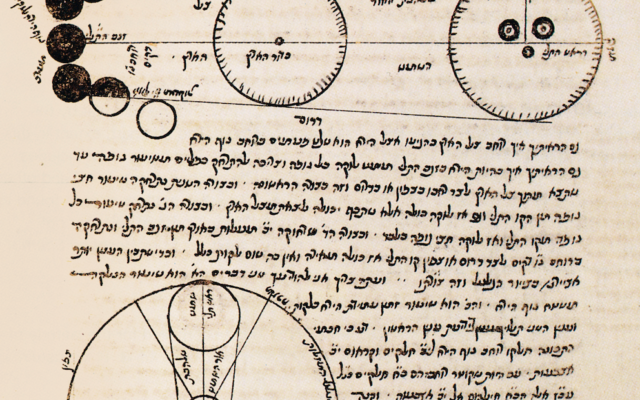From Abraham and the sages to space travel
“And He [God] said [to Avraham] look to the heavens and count the stars if you are able to count them” (Bereshit 15:5). “And lest you lift up your eyes to the heavens and you see the sun and the moon and the stars, all the hosts of the heavens” (Devarim 4:19). “Rabban Gamliel had illustrations of the shapes of the moon on a tablet and on the upper wall of his chamber, which he showed to the potential witnesses [at the time of sanctification of the month] and he said ‘did you see like this or like this?’” (Mishnah Rosh Hashanah 2:8).

As of last week, Daf Yomi program participants commenced study of tractate Rosh Hashanah which opens our eyes to the extent of the sages’ knowledge of astronomy used in computations and calculations relevant to our calendar.
Additionally it is at this time of year that we focus on Abraham in our readings of parashiyot; just last week we read the verse cited above instructing him to look to the stars in the heavens.
And thirdly, as these lines are written final preparations are underway for a second Israeli astronaut to travel into space where he will indeed observe the heavens.
In the context of all of the above, I felt that a few comments on astronomy and interest in the heavens in Jewish sources are in order.
Despite the wording of the second commandment banning images of that which is in the heavens, Rabban Gamliel kept charts of the phases of the moon.
There can be no question as to the familiarity of the sages with the science of astronomy. True, the Torah seems to be concerned with those who might seek to worship the heavenly bodies as so many of the ancients did. Nevertheless, astronomy was an essential part of practical Judaism.
The fact that Hillel II was able to provide us with the basic framework of a calendar that to this day still has Rosh Chodesh coincidental with the new moon, indicates the extent to which he and his contemporaries were familiar with the intricacies of the lunar cycle. In fact one can only marvel at the extent of his success which did not come about with the aid of a computer utilising electronic technology which any of us embarking on such a project would consider essential.
But beyond that there are many references in talmudic literature to the stars.
There was also some overlap between astronomy and astrology. The astrological signs that are based on constellations actually relate to the Hebrew months; they too were the subject of ancient Jewish art as evidenced by the famous mosaic floor of the synagogue at Beit Alpha. But the relationship with astrology does not detract from the sages’ astronomic knowledge, which extended even to knowledge of a comet (Halley’s comet!) that appeared once in 70 years (Horayot 10a).
Subsequent centuries saw a number of significant astronomers among great rabbis. The 12th century biblical commentator Abraham Ibn Ezra compiled astronomical tables on the movements of the then known planets; he also wrote a series of theoretical texts on astronomy, including Sefer HaIbbur, on the subjects of cycles, the new moon, seasons and signs of the zodiac.
Abraham Ibn Ezra, best known for his commentary on Chumash that pays particular attention to Hebrew grammar, also explained the use of instruments such as the astrolabe.
Jewish astronomical work continued throughout the Golden Era of Spanish Jewish life; the tables and almanac of Abraham Zacuto were used by Columbus on his voyages, which began at that very moment in history that the Jews were exiled from Spain. Rabbi Moses Isserles, famous for his glosses on the Shulchan Aruch in accordance with European (Ashkenazi) custom, also wrote on astronomy. And long before Copernicus, the Zohar stated that: “The whole earth spins in a circle like a ball; the one part is up while the other part is down; the one part is light while the other is dark; it is day in the one part and night in the other.”
However in the contemporary era our interest in the heavens is not just historic or theoretical.
In 1982, the Israel Space Agency was created to coordinate the space program of Israel.
Its mission as defined in 2005 stated: “Space research and exploration is an essential instrument for the defence of life on Earth; the lever for technological progress; the key to existing in a modern society; essential for developing an economy based on knowledge; and the central attraction for scientific and qualified human resources.”
The vision is: “To preserve and broaden the comparative advantage of Israel and to place it among the group of leading countries in the space research and exploration area.”
Yet even that approach based on modern needs can be seen as an extension of our past history. At a 2020 press conference in Yerushalayim arranged to announce his forthcoming space journey, Eytan Stibbe – who, as the second Israeli into space, will shortly travel to the international space station on a shuttle launched from Florida – spoke of his interest in space in almost biblical terms.
“As a child, on dark nights I looked up to the stars and wondered what there is beyond what I saw,” Stibbe told the conference in the presence of Israeli president Reuven Rivlin.
Indeed, like his predecessor and close friend Ilan Ramon who unfortunately did not survive his space flight, pioneering Israeli astronauts and those scientists who made their work possible are following in the footsteps of so many of our forebears whose knowledge extended beyond purely spiritual realms and contributed to the science and understanding of the vast universe that surrounds our insignificant planet.
Shabbat shalom,
Yossi
Yossi Aron OAM is The AJN‘s religious affairs editor.

comments